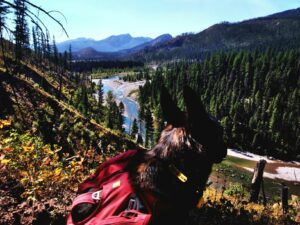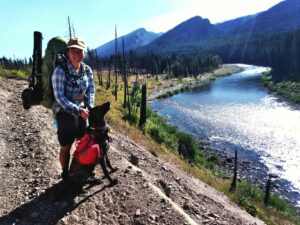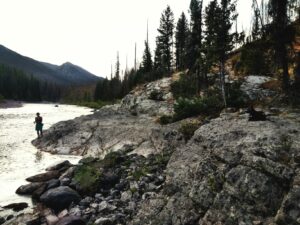Barks Blog
Maintaining a Rewarding Relationship with Your Dog
By Tiff Shao
*This post is a selected entry from the Pet Professional Guild Writers’ Competition for Geek Week 2020 *

The aquamarine waters looked extra enticing as we approached the river crossing. It was a hot August day and the previous section of the trail offered no shade. My dog Braeburn splashed in the chilly, mountain-fed waters and drank his fill.
We had a few miles under our soles, and a total of five days to trek 40 in total. Our locale was the Bob Marshall Wilderness – land of pristine rivers, bountiful fish, wildfires, and grizzly bears.
Though I am a professional trainer, my dog was off leash and I did not have treats or toys. We crossed paths with pack mules, hikers… and thankfully no bears. Brae was perfectly compliant, and we navigated the trails with relative ease.
I could focus on other aspects of trail safety and enjoy the breathtaking scenery. And yet, I reflected on the path that took us to this point where I could hike with confidence, and without the classic training tools that convince my dog to listen to me.
As a trainer in Montana, I often work with clients whose goals are similar – ‘train my dog to listen off leash so I can hike without having to worry about him.’ The stipulation is no one wants to carry around a smelly treat pouch.
I want to share a little slice of my journey to show how I reached that objective. The technical end goal of training results from deeper, rewarding, relationship building between a person and their dog.
Learning a Behavior
The learning of any behavior goes through a process: acquisition, fluency, generalization, and maintenance.
Acquisition and fluency are easy enough – beginning to teach a dog to sit and then having him reliably do it on cue, as an example.
Generalization is trickier. It takes practicing a single behavior in many different situations for that behavior to become generalized. Wouldn’t it be nice if all of that coming when called practice in the yard worked perfectly when your dog is off leash on a hike? Unfortunately, it isn’t so easy. Reliability comes with hours of training, under the pressure of various distractions, in many different locations.
The end result is maintenance of those hard-learned behaviors. Though even the term “end result” is a fallacy.
By very definition, “maintenance” suggests that efforts must be taken for the behaviors to continue. But how many people dream of the day when they no longer have to cut up cheese before a walk? When they no longer have to carry a treat pouch on their hips? If maintenance means more training, where is the promised “end result” and the ever-obedient dog?
Training Never Ends

I relish the idea that training never ends. In fact, I never want it to. I learn just as much from my dog as he does from me. But perpetual training is hard sell to a client who simply wants to hike with her dog without hotdog grease on her fingers and not worry about rewarding a check-in every minute.
I can talk about maintenance in technical terms – reward schedules and gradual reduction of rewards and so on. But in simpler terms maintenance, to me, is the upkeep of the relationship my dog and I have developed. And a relationship is a two-way street.
A relationship involves listening to each other’s needs. I want Brae to listen to me when I ask him to sit and stay next to me as horses pass on the trail. I want him to remain in proximity while I fish.
My dog may want to say ‘hi’ to the horses, or sniff off trail while his boring human pretends to throw sticks (but actually doesn’t) over and over again towards the water.
But Brae listens to me. And he knows I listen to him.
I will not let him greet the horses but I will satiate his desire for social interaction by scratching his neck as they pass.
I will not let him wander away while I fish, but I also keep an eye on him and take breaks from fishing to play if he looks a little antsy. The results are still mutually beneficial – we both remain safe and happy on the trail.
A relationship is fair. I could enforce a sit/stay one foot off the trail using treats (my preferred method), or tightly holding Brae’s collar, or hoping that through all our training he can do it on his own under such intense distractions.
But what benefit is there to me, my dog, the horses, or the rider, if Brae was rigidly sitting one foot off the trail?
The temptation for my dog lessens greatly, safety increases drastically, and we can all inhale less of that trail dust, if I moved 10 feet off the trail before asking my dog to stay.
Fairness is also what keeps us safe. I expect Brae to carry the weight he’s been positively conditioned to carry, to follow cues that we’ve practiced on countless trails before, and to be calm around animals that I’ve cautiously trained around in controlled situations.
It would be unfair of me to go from neighborhood walks and training, to loading Brae with a heavy pack and expecting him to stay perfectly calm around horses without practice.
Rewarding Relationship

A relationship is rewarding. Why would I ever want to stop giving Brae treats, petting, toys, and attention? Even outside of formal training sessions, I got a dog so I could shower him with these things.
If you asked me 10 years ago what the most important part of dog ownership was, I would have said obedience. Various media and outspoken people had tricked me into believing that. My dog back then was obedient, but I was more punitive when my dog ‘did something wrong’ and overall it was less fun.
Fast forward to how I train today (positive reinforcement based training) and an interesting side effect is Brae is more obedient than I ever thought possible.
Here is the difference with both my high drive dogs: My first dog once chased a bear cub and I was able to call him off. Brae has alerted me to three bears without chasing them at all. In grizzly country, that is a critical difference.
Having a rewarding relationship is how I was able to hike 40 miles without using a leash or treats and still have not a single hiccup with my dog. The rewards were not in my pocket. I was the reward for Brae, and being able to go on this adventure with my dog was the ultimate reward for me.
Back to this concept of maintenance in training. This post is not about how I taught my dog to believe that hanging out with me is cooler than chasing horses and bears, to stay close on the trail, and comply with my cues. (Though it’s no secret – I took plenty of hikes with pocketfuls of treats, and toys tucked under my arm, using leashes and long lines to prevent mistakes and keep my dog and others safe.)
This post is about how I embraced the journey with my dog and no longer needed those tools. The more you embrace the idea of bringing rewards everywhere, all the time, the more likely your dog will listen even when you don’t have them.
It sounds paradoxical, but it’s true.
There is a technical side to fading rewards and reaching the maintenance stage. But the less you think about it, the less you rush to eliminate treats, and the sooner you will seamlessly find yourself at that stage.
I still bring treats or toys on walks sometimes, even though Brae is “trained” by every definition of the word. I’m maintaining my side of the relationship, in which my dog knows I often have great things for him. In exchange, my dog maintains his half of the relationship, the side society calls “being well trained” but what I call being my best bud.
And so, my attention was focused on preventing the hook of my lure from getting stuck in the rocks.
Daylight was waning as I cast into the river. If someone could train me to fish half as well as I trained my dog, it wouldn’t require nearly as much effort and I would catch more fish.
Every now and then I’d glance behind me. Brae was there, lying further up on the bank and keeping watch. Sometimes the thwip of the rod would cause him to perk up.
At some point Brae learned that this whole ‘fake fetch’ business was actually worthwhile – all it took was feeding him some leftovers from said ordeal. I could do this forever. This, listening to the rushing waters, breathing in the smoky pine aroma, watching the sun fall behind the charred mountains.
The beautiful thing about training is at the maintenance stage it simply feels like living. Just the silhouette of a girl and her dog in the Rocky Mountain wilds.
About the Author
Tiff Shao CPDT-KA is the behavior manager at the Humane Society of Western Montana in Missoula, Montana). She oversees the behavior modification and enrichment programs at her shelter. She also manages community training programs like puppy socialization classes, basic manners, private lessons, and more. Her favorite part of the job is working with pets and their guardians towards developing happy, rewarding relationships.

